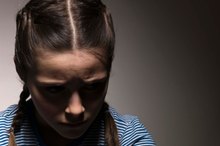What does fact checked mean?
At Healthfully, we strive to deliver objective content that is accurate and up-to-date. Our team periodically reviews articles in order to ensure content quality. The sources cited below consist of evidence from peer-reviewed journals, prominent medical organizations, academic associations, and government data.
- “Journal of Clinical Psychiatry”; Early-Onset Bipolar Disorder and Treatment Delay are Risk Factors for Poor Outcome in Adulthood; Robert M. Post et al.; July 2010
- “Journal of Clinical Psychiatry”; Early-Onset Bipolar Disorder and Treatment Delay are Risk Factors for Poor Outcome in Adulthood; Robert M. Post et al.; July 2010
The information contained on this site is for informational purposes only, and should not be used as a substitute for the advice of a professional health care provider. Please check with the appropriate physician regarding health questions and concerns. Although we strive to deliver accurate and up-to-date information, no guarantee to that effect is made.
Signs of Bipolar in a Five-Year-Old
The idea that bipolar disorder in young children is rare is increasingly being challenged, according to Arman Danielyan and colleagues in 2007 in the “Journal of Affective Disorders.” In fact, one estimate cites that 70 percent of cases of bipolar disorder onset at age 5 or younger, the researchers note 1.
If you are experiencing serious medical symptoms, seek emergency treatment immediately.
Diagnosis
The current diagnostic model requires that there is a distinct period of abnormally and persistently elevated, expansive or irritable mood with a duration of four days for a hypomanic episode, as discussed by Danielyan and colleagues. The requirement that episodes of mania must be distinct presents a challenge when diagnosing young children because they tend to cycle through mania rapidly.
Characteristics
What Is Morbid Depression?
Learn More
Young children tend to have a more severe and developmentally complicated subtype of bipolar disorder where there tends to be a poorer course and fewer remissions, according to Danielyan and colleagues. In children as young as 5, bipolar disorder frequently manifests as daily mood swings, short episodes of intense mood, hostile and aggressive behaviors, and chronic irritability, the researchers note.
Similarities
Since bipolar disorder in young children transitions rapidly, symptoms tend to overlap that of other disorders 1. Therefore, a child cycling rapidly through the phases of bipolar disorder may mistakenly be thought to have other disorders or a combination of other conditions. In fact, bipolar disorder is often misdiagnosed as ADHD, major depressive disorder, conduct disorder and other psychiatric conditions, the researchers note. This is problematic because treatment delays are linked to poorer outcomes with the disorder in adulthood, as found in a study conducted by Robert Post and colleagues published in the July 2010 issue of the “Journal of Clinical Psychiatry. 2”
Considerations
Affective Symptoms in Mental Health
Learn More
Since bipolar disorder is a complicated disorder in young children, it is difficult to label appropriate behavioral outcomes. The estimates for early onset bipolar disorder may be lower than the actual prevalence rate. For one, there is a scarcity of data regarding diagnostic criteria for children diagnosed with bipolar disorder prior to age 7, note Danielyan and colleagues.
Causes
Bipolar disorder is caused in part by genetic factors that predispose children to having the disorder. In stressful situations, those prone to developing the disorder are likely triggered by stressful events in the environment. Over time, the disorder maintains itself and environmental stressors are no longer required to trigger episodes, according to Bryan Kolb and Ian Whishaw in the 2003 book “The Fundamentals of Human Neurospychology. 3”
- Bipolar disorder is caused in part by genetic factors that predispose children to having the disorder.
- In stressful situations, those prone to developing the disorder are likely triggered by stressful events in the environment.
Related Articles
References
- “Journal of Affective Disorders”; Clinical Characteristics of Bipolar Disorder in Very Young Children; Arman Danielyan et al.; 2007
- “Journal of Clinical Psychiatry”; Early-Onset Bipolar Disorder and Treatment Delay are Risk Factors for Poor Outcome in Adulthood; Robert M. Post et al.; July 2010
- “The Fundamentals of Human Neurospychology”; Bryan Kolb and Ian Q. Whishaw; 2003
- Issler CK, Monkul ES, Amaral JA, et al. Bipolar disorder and comorbid obsessive-compulsive disorder is associated with higher rates of anxiety and impulse control disorders. Acta Neuropsychiatr. 2010;22(2):81-86. doi:10.1111/j.1601-5215.2010.00457.x
- Perugi G, Akiskal HS, Pfanner C, et al. The clinical impact of bipolar and unipolar affective comorbidity on obsessive-compulsive disorder. J Affect Disord. 1997;46(1):15-23. doi:10.1016/s0165-0327(97)00075-x
- American Psychiatric Association. Diagnostic and Statistical Manual of Mental Disorders. 5th ed. Washington, DC: 2013.
Writer Bio
Based in Southern California, Danielle Hall has been researching and writing in the area of health behaviors since 2007. Her area of expertise is health disparity reduction through behavioral change. Hall holds a Master of Science in psychology and a Ph.D. in psychology from Walden University.









